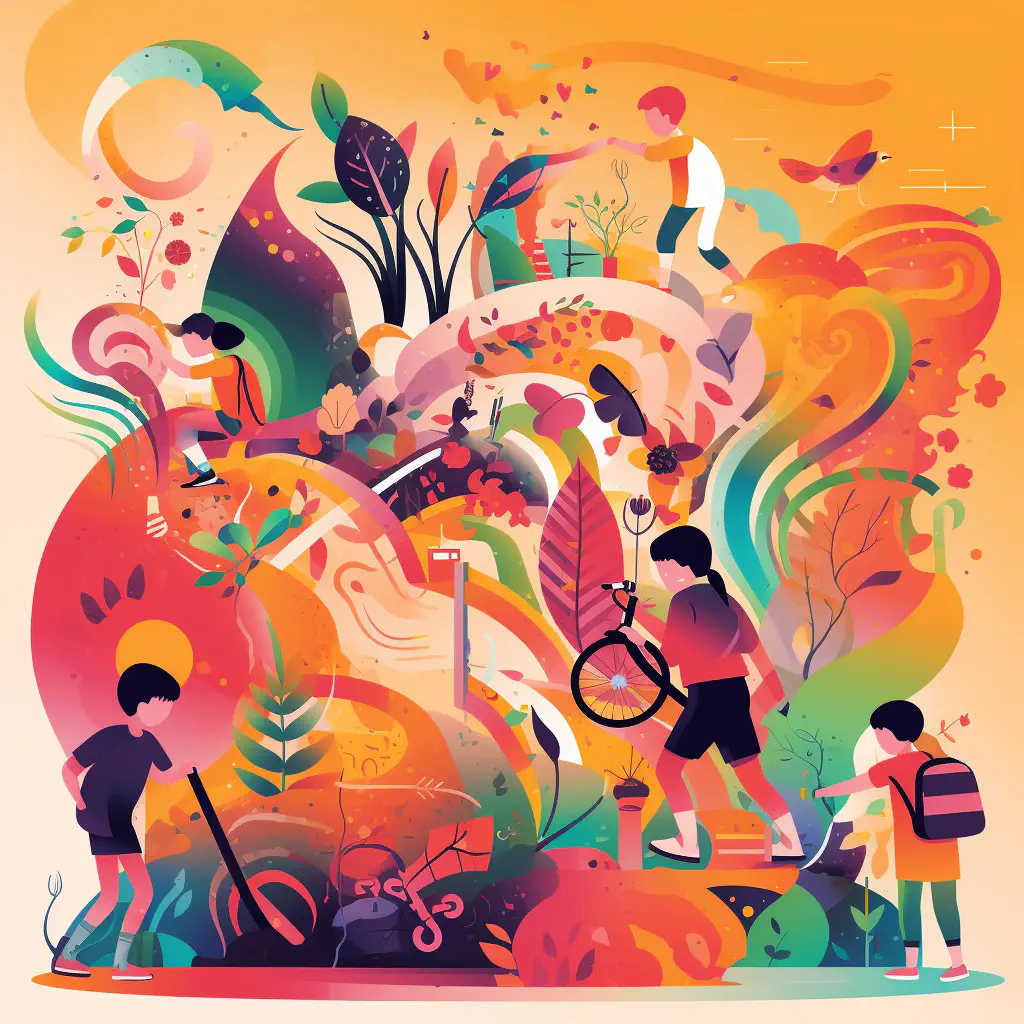
1. Take Them on Adventures
One of the best ways to ignite curiosity in kids is by taking them on adventures. Here are some ideas to get you started:
Explore the great outdoors
Take your kids on outdoor adventures like hikes, camping trips, and nature walks. Along the way, point out interesting plants, animals, and geological formations and let your kids ask questions.
Visit historical sites
Explore historical sites like national parks, battlefields, and monuments. This is a great way to teach your kids about the rich history of their country and the world.
Discover new cultures
Expose your kids to different cultures by taking them to cultural events or visiting cultural landmarks. This can help them gain a deeper understanding of the world and broaden their perspectives.
Go on treasure hunts
Create treasure hunts for your kids where they have to solve clues and puzzles to find hidden treasures. This can help them develop critical thinking skills and problem-solving abilities.
Take a road trip
Hit the open road and explore the world outside your hometown. This is a great way to bond with your kids and give them a sense of adventure.
Remember, the key is to encourage your kids to ask questions and explore the world around them. With a little creativity and some planning, you can ignite their curiosity and help them develop a love of learning that will stay with them for a lifetime.
2. Let Them Choose Their Own Books
Reading is a vital tool for learning and expanding knowledge. Encouraging kids to read early on can help instill a lifelong love for books. Here are some ideas to help kids choose their own books:
- Visit the library or bookstore and give them time to peruse the shelves. It is essential to provide a comfortable and inviting environment so that they feel encouraged to explore.
- Ask them about their interests and suggest books that might align with those interests. This approach will help them learn to select books based on topics they enjoy.
- Encourage them to read books at their level and beyond. It is vital to challenge them but avoid overwhelming them with too complicated texts.
Letting kids choose their own books empowers them and makes reading more enjoyable. It gives them a sense of ownership, thereby helping them develop a love for reading that can last a lifetime.
3. Encourage Their Creativity
Provide Plenty of Materials
Kids love to create, and providing a variety of materials ensures they have everything they need to let their imaginations run wild. Consider having a designated creative space where kids can easily access materials like:
- Paints (watercolor, tempera, acrylic)
- Markers, crayons, and colored pencils
- Construction paper and cardstock
- Glue sticks and liquid glue
- Scissors and rulers
- Playdough and modeling clay
Try New Techniques
Encourage kids to try new techniques to keep their creativity flowing. Here are a few ideas:
- Collage making: Using a variety of materials, kids can create a unique design by sticking them onto a base surface.
- Printing: With simple materials like foam sheets, kids can make their stamps and create unique prints.
- Sculpting: Using clay or other moldable materials, kids can create three-dimensional art pieces.
Allow for Unstructured Time
Unstructured creative time allows kids to explore their imaginations freely. Giving them this time allows them to come up with ideas and solutions on their own. Avoid interrupting during this time, and let them know it is OK not to have any plans or goals during that time.
Encourage Art Shows and Sharing
Encouraging kids to share their creations shows them it is OK to express themselves creatively. Hold a family art show, invite friends and family to attend. This is an excellent way to help kids learn how to receive fair and constructive feedback while also showing pride in their creativity.
4. Introduce Them to Science
Science can be thrilling, especially for kids who love to experiment and observe. Here are some ways to introduce them to science:
- Set up simple science experiments at home: You don’t need a fancy lab to conduct science experiments. Use everyday materials like baking soda, vinegar, and food coloring to create simple but fascinating experiments that will spark their curiosity.
- Take them to science museums: Museums are a great way to teach kids about science in a fun and interactive way. Many science museums have hands-on exhibits where kids can learn about everything from electricity to space travel.
- Watch science documentaries: There are plenty of science documentaries that are both educational and entertaining. Check out channels like National Geographic or the Discovery Channel for documentaries that will teach your kids about different scientific concepts.
- Explore the outdoors: The natural world is full of scientific wonders. Take your kids on nature walks and teach them about the plants and animals they see. Encourage them to ask questions about the world around them and use their observations to come up with scientific theories.
- Teach them about the scientific method: The scientific method is the foundation of all scientific inquiry. Teach your kids about the steps of the scientific method and encourage them to use it when conducting their own experiments.
- Provide them with science kits: Science kits are a great way to provide your kids with the materials and instructions they need to conduct their own experiments. From chemistry sets to robot building kits, there are science kits available for all interests and skill levels.
5. Use Educational Apps
In today’s digital age, educational apps are a great way to make learning fun and engaging for kids. Here are a few types of educational apps that your kids might enjoy:
Math Apps
Math can be a difficult subject for some kids, but there are plenty of fun math games and apps that can make learning arithmetic and problem-solving more enjoyable. Some apps even use gamification to motivate kids to practice their math skills.
Language-Learning Tools
Learning a new language can be a fun and rewarding experience, especially for kids who are interested in different cultures. Language-learning tools, like Duolingo, allow kids to learn new words and phrases in a game-like interface.
Coding Games
Coding is becoming an increasingly important skill in the modern world, and there are lots of coding games and apps that make learning programming concepts both fun and accessible. Kids can learn the basics of coding through games and activities that allow them to build their own programs.
Science Apps
Science can be a fascinating subject for kids who are curious about the world around them. There are educational apps that teach kids about different branches of science, like biology, chemistry, and physics, through interactive activities and simulations.
Whether your kids are struggling in certain subjects or simply want to learn more about the world, educational apps can be a valuable tool for igniting their curiosity and helping them expand their knowledge.
6. Make Learning a Game
Learning doesn’t have to be boring! By turning education into a game, it can become a fun and exciting experience. Here are some ideas:
Board Games:
Board games are a classic way to make learning fun. Games like Monopoly teach kids about financial management, while Scrabble helps them improve their vocabulary and spelling skills. There are plenty of board games available for various subjects, making learning an enjoyable experience.
Trivia Games:
Trivia games are an excellent way to reinforce facts and knowledge. You can create your own trivia game based on any subject, from history to science and beyond. Alternatively, there are games like Brain Quest that offer age-appropriate trivia questions for kids.
Storytelling Games:
Storytelling games encourage creativity and imagination and are an excellent way to teach literacy skills. Games like Once Upon a Time or Story Cubes challenge kids to create stories from different cues or prompts.
Video Games:
Video games can provide a great learning experience when they’re designed for educational purposes. Games like Minecraft help kids learn about problem-solving and strategy, while coding games like Scratch teach kids about computer programming.
By incorporating games into learning, kids can have fun while expanding their knowledge. Remember to make the experience age-appropriate, challenging, and enjoyable!
7. Start a Collection
Collections are not only fun but also a great way to ignite curiosity in kids. Here are some tips on how to help your child start their collection:
Find a Theme
The first step is to decide on a theme. This could be anything from stamps to seashells, or even vintage toys. Encourage your child to choose something that they’re interested in or passionate about.
Research
Once you have a theme, do some research together. Look for books or online resources that can help your child learn more about their collection. This is also an excellent opportunity to teach them how to do research and find credible sources.
Get Organized
Invest in some storage containers, like plastic bins or display cases, to keep the collection organized and safe. Label each item with its name and any relevant information, such as where it was found or its age.
Go on Quests
Encourage your child to go on quests to find new items to add to their collection. This could involve visiting garage sales, thrift shops, or even heading out to nature to find new specimens. Not only can this activity spark curiosity, but it’s also an excellent way to encourage outdoor exploration.
Share with Others
Finally, encourage your child to share their collection with others. This could be through showing off their items to friends, participating in show-and-tell at school, or even attending collector conventions. Sharing their collection can help build confidence and communication skills while also opening them up to new ideas and perspectives.
Starting a collection is not only a fun activity but also a valuable learning experience. It can teach kids about history, science, and the importance of preservation. So, why not help your child start their collection today?
8. Watch Educational Videos
Watching educational videos can be a fun and informative way to learn. Here are some ways to incorporate videos into your child’s learning:
- Find age-appropriate videos: Look for videos that are appropriate for your child’s age and interests. YouTube Kids is a great resource for finding educational videos for younger kids.
- Create a watchlist: Make a list of educational videos your child can watch during their free time or as part of your homeschooling curriculum.
- Make it interactive: Pause the video and ask your child questions or have them summarize what they just learned. This can help them retain information better.
- Supplement school subjects: Watch videos related to subjects your child is learning in school. This can reinforce what they’ve learned and provide additional context.
- Explore new subjects: Introduce your child to new subjects through educational videos. They may discover a new interest they never knew they had!
- Use videos for research: If your child is working on a school project or writing a report, use educational videos as a source of information.
- Watch together: Watching educational videos with your child can create bonding experiences and facilitate discussions about what they’ve learned.
Remember to always monitor what your child is watching and make sure the videos are both educational and appropriate for their age. Happy learning!
9. Take Them on Field Trips
Field trips can be a fantastic way to supplement traditional classroom learning. Here are a few ideas for field trips that can be both educational and fun:
-
Visit a local farm: Kids can learn about sustainable agriculture, plant growth, and animal care. They might even get to pet a few animals!
-
Tour a factory: Many factories offer tours where kids can see how products are made and learn about the various jobs that go into manufacturing.
-
Go to a zoo or aquarium: These trips provide kids with the opportunity to see and learn about animals from all over the world.
-
Visit a historical site: Whether it’s a battlefield, museum, or landmark, historical sites can teach kids about the past and help them understand the present.
-
Explore a local business: Kids can learn about different careers, entrepreneurship, and economics by touring local businesses.
Remember to research and plan ahead before taking your kids on a field trip. Some locations may require reservations or advance notice, and it’s important to make sure the trip aligns with their interests and learning goals.
10. Make Learning Personal
Learning becomes more meaningful when it is connected to a child’s personal experiences and interests. Here are some ways to make learning more personal for your child:
Connect Interests to Subjects
Talk to your child about their hobbies and interests, and find ways to connect them to different subjects. For example, if they love animals, explore the science behind animal behavior, or if they enjoy music, delve into the math and physics behind sound waves.
Incorporate Life Skills
Teach your child practical life skills while also reinforcing academic subjects. For example, show them how to measure ingredients while baking to reinforce math concepts, or teach them about money management to reinforce financial literacy.
Relate Lessons to Real-World Situations
Help your child understand how academic subjects relate to real-world situations. For example, if they are learning about fractions, show them how to use fractions while measuring ingredients while cooking.
Encourage Experimentation
Allow your child to experiment and try things out for themselves. This not only helps with problem-solving skills but also reinforces academic subjects. For example, if they are learning about plants, start a garden and let them experiment with different types of soil and seeds.
Personalize Learning Materials
Personalize your child’s learning materials to match their interests and learning style. For example, if they are a visual learner, use diagrams and graphics to illustrate concepts. If they enjoy storytelling, introduce lesson plans in a narrative format.
By making learning personal for your child, they will be more engaged in the learning process and retain the information better. This can lead to a lifelong love of learning and curiosity about the world around them.

